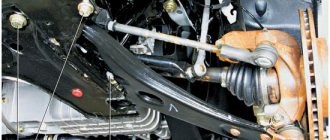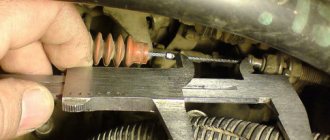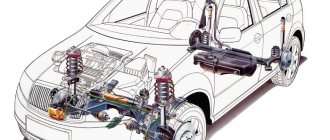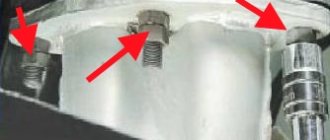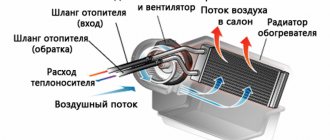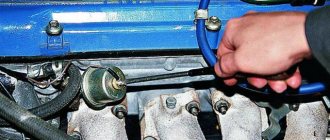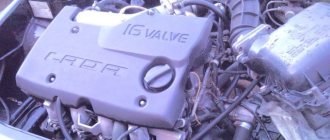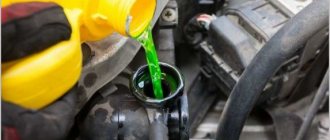Every vehicle owner should know what silent blocks are, their types, main functions, installation locations, factors influencing rapid wear, as well as how to replace them.
|
|
|
|
What is a silent block?
The silent block is a structure made of a metal sleeve, which is inserted and securely fixed into a rubber or polyurethane product that has the appearance of a tube. The part is a rubber-metal hinge and comes with or without an outer metal shell.
Despite the simplicity of the device, the part determines the safety of the car during its operation, as well as comfort for the driver and passengers. It is worth noting that silent blocks are used not only in vehicles. They are found in some models of motorcycles and bicycles.
What is a silent block?
Difficulties during work
A few words about possible difficulties. They consist in the fact that the inner race of the silent block can stick to the axle or bolt.
And if there are fewer problems with the lower arm, since the impact forces that we create with a hammer, when pressed out, allow the hinge to be torn out of place, then with the upper arm everything is more complicated.
One way out of this situation is to cut the lever. Using a grinder, we cut off the lever so that only the eyes with silent blocks remain at the place where it is attached to the body.
The lever is then removed from the car. Next, using the same grinder, we cut the fastening bolt at the junction of the silent blocks with the car body. That is, parts with hinges are cut off.
After this, remove the remaining bolt from the hole in the body. This method is one of the fastest in the fight against stuck joints. But you will have to purchase a new upper arm and mounting bolt.
To avoid this problem in the future, it is necessary to lubricate the axle and mounting bolt with nigrol.
What do silent blocks do?
In a car, the silent block performs the connecting function of its suspension components, which provides resistance to shocks and vibrations on the body when driving, and also protects expensive parts from premature wear. Silent blocks absorb the effects of load forces that are generated when vehicles move on the body and load-bearing parts of suspension units.
What do silent blocks do?
What are they and what is the difference?
Depending on the material of manufacture, silent blocks are divided into:
- rubber;
- polyurethane.
According to its design features:
- with one bushing;
- with two bushings;
- rubber silent block without metal elements.
Depending on the design requirements for vehicle suspension elements, they can be divided according to the rigidity of the fastening:
- ensuring permissible movement of the part;
- guaranteeing a large range of motion.
The main criterion for the quality of silent blocks is their reliability, wear resistance and durability in operation. These factors are determined by the material of manufacture.
When choosing a silent block, it is worth considering the nature and intensity of vehicle operation. However, the quality advantage lies in the direction of polyurethane. Their cost, compared to rubber ones, is an order of magnitude higher. The main advantages of polyurethane silent blocks include:
- high quality material ensuring durable operation;
- immunity to temperature changes;
- resistance to the effects of chemicals used during icing of the road surface;
- improving vehicle controllability due to the elastic properties of the material;
- Improved shock and vibration absorption.
What are they and what is the difference?
Floating silent blocks are also installed on the suspension arms. A floating silent block is also a hinge, but a ball joint. Together with shock absorbers and other silent blocks, it provides the car with all modern speed advantages, as well as the dynamics of acceleration, braking and handling.
PURPOSE AND DESIGN FEATURES OF THE BUSHING BLOCK
There are one more element in the design - silent blocks. These small-sized parts with a simple design play a fairly important role. Their task is to dampen vibrations and prevent their transmission between the components of the suspension. They are connecting elements of the structure; connections of a number of parts are made only through silent blocks. That is, these parts are directly involved in the main task of the suspension.
Silent block refers to rubber products used in the construction of a car. At the same time, it is a consumable material, which, as a result of wear and tear, is simply replaced, since it cannot be repaired.
The design of this part is very simple and includes only two main components:
- metal clips;
- and a rubber spacer between them.
Thanks to the use of rubber, it is possible to dampen vibrations and vibrations received from one component of the suspension, and not transfer them to another.
Outwardly, it looks like a massive bushing that fits into a special seat in the suspension element, but in essence it is just an elastic hinge that connects the parts into one unit. Thanks to the hole in the inner frame, the element in which it is installed to another component of the suspension or body is fastened.
There are also silent blocks, in which only the internal clip is used in the design, and the role of the external one is played by the seat itself in the suspension element.
How silent block works
When driving, vehicles are exposed to a large number of negative influences (vibrations, shocks, vibrations). The mounting points of the suspension parts are subject to many frictional forces, due to which the service life is sharply reduced.
To avoid side effects, the design of the vehicle provides for the connection of chassis parts using silent blocks, the function of which is to reduce friction between the connections, as well as absorb vibrations and vibrations for a comfortable ride.
How silent block works
The design of silent blocks, how they work
The structure of a typical silent block
So, the main structure of silent blocks is clear: it is a rubber-metal hinge (RMH), designed for movable fastening of two rigid parts. Moreover, the rubber layer is bonded to the metal elements not only due to pressure (as a rule, in such hinges the elastic part is compressed before being pressed into the metal), but also due to fixation with a special glue or “welding” during the vulcanization process.
Where are the silent blocks located?
The installation locations of silent blocks are determined by the design of the vehicle model. Most often they are installed:
- in the upper and lower arms of the front suspension;
- on the transverse arms at the point of attachment to the body;
- at the ends of the stabilizer when attached to the wishbone;
- on shock-absorbing struts;
- at the ends of the wishbones;
- in the areas where the beam connects to the body eyelets;
- in the connection of the steering mechanism with the rods.
Design features of silent blocks
What is a silent block? The classic definition of this structural element is a rubber-metal hinge, made, as a rule, in the form of two metal bushings inserted concentrically into one another with a rubber or polyurethane filler between them.
According to the installation location, silent blocks are divided into three groups:
- Front suspension (with predominant torsional deformations): mounting of shock absorbers, stabilizers, levers;
- Rear suspension (torsional deformations also predominate): shock absorbers, stabilizers, rear beam fastening elements;
- Elastic mounting elements for the engine and gearbox (prevalence of compression and bending deformations - use as vibration isolators).
Schematic examples of installing silent blocks in various places of the car are presented in the following figure:
Of course, the specific dimensions and additional structural elements (for example, collars) of silent blocks, their number and specific installation locations are determined by the design of the vehicle's chassis system, but the operating principle and basic design are the same.
During operation, the elastic element of the silent block experiences high cyclic loads and therefore the requirements for the material are also quite stringent: as a rule, these are elastomers based on natural rubber. Modern materials are also used as an elastic element: polyurethane and polyurethane with natural rubber additives.
Polyurethane silent blocks are somewhat stiffer than rubber ones, but at the same time they are significantly (4 - 5 times) more durable (and more expensive).
Signs of silent block failure
Since silent blocks are classified as consumable materials of the chassis, to ensure safety during vehicle operation, it is recommended to know their service life and durability, which is determined by the manufacturer in its regulations.
Has your car's handling become worse?
Not really
In most cases, a rubber-metal joint lasts for about 100 thousand kilometers. In countries with increased negative factors of use (weather conditions, quality of roads), silent blocks must be diagnosed every 60 thousand kilometers.
The need to replace a part is determined by the sensations while driving a vehicle, namely:
- instability in control (the turning of the car’s steering wheel has become slow);
- extraneous impact noises from the suspension when driving on a dirt road;
- instability of the direction of movement;
- steering wheel vibration;
- the appearance of creaks and uncharacteristic vibrations;
- uneven tire wear, provided there are no other influencing reasons;
- Wheel camber/toe is not normal.
Signs of silent block failure
What is the purpose of the suspension arm silent block?
These parts consist of two metal bushings (internal and external), and between them there is a rubber insert, which is most often made of polyurethane, so sometimes you can come across such a thing as a “polyurethane silent block”. It is this insert that plays the most important role. The silent block of the suspension arm connects its elements ; in addition, such parts are widely used for mounting the gearbox, shock absorbers, and even the engine.
It is quite difficult to underestimate their role in the car, so it is necessary to monitor their condition. In general, manufacturers usually provide a guarantee for as much as one hundred thousand kilometers, but given the “wonderful” condition of our roads, you should not be guided by this figure; it is better to carry out a visual inspection at least after 50 thousand. Moreover, you can assess the condition of the rear silent blocks of the front control arms yourself at home.
How to check silent blocks?
Determination of the technical condition of silent blocks is carried out on specialized overpasses, lifts, and inspection pits. To complete the work, you need to have an idea of the appearance of the new silent block and its dimensions. For diagnostics, a pry bar and a specialized tool are often used.
Expert opinion
Anton
Experienced auto mechanic and specialist in car chassis repairs
Ask a Question
I strongly recommend replacing silent sides on time. As soon as you feel deterioration in control or extraneous sounds from the chassis of the car, immediately make a diagnosis.
During the inspection, they look at the integrity of the part and its design parameters (a working silent block should not have cracks, breaks or unforeseen gaps in the connections).
The procedure for determining the state of silent blocks is as follows:
- after installing the vehicle on the overpass (lift, inspection hole), parts are cleaned from external contaminants;
- a visual inspection is carried out;
- ball joints are dismantled;
- the parts associated with the silent blocks are checked. To do this, by loosening the suspension arm to the sides, you need to make sure that it springs back to its original position (indicating its serviceability);
- the bushing is checked (it should not rotate relative to the lugs);
- the silent block itself is checked for the presence of knocks inside the part, as well as visible cracks and damage to the rubber and metal elements;
- Using a pry bar or other specialized tool, a check is made for the presence of play in the silent blocks (if it is detected, the part requires urgent replacement).
The procedure for determining the technical condition is not a difficult job, but its implementation requires basic knowledge of vehicle structures.
Since the technical condition of silent blocks directly affects the overall safety of vehicle operation, it is worth taking care of their timely replacement. Otherwise, this can lead to loss of vehicle control when driving, damage to the front suspension arm, destruction of the silent block mounting points, and asymmetric tire wear.
How to check silent blocks?
How to quickly replace a silent block?
Due to the fact that the silent blocks fit on the levers and other elements quite tightly, not every car owner will risk changing the silent blocks on their own. However, if you already have skills in car repair and locksmith work in general, even an inexperienced driver will be able to cope with the task. An example of how such hinges can be changed without special equipment. shown in the video below.
To work, you will need wrenches to dismantle the damaged lever (most often you have to change them on the suspension arms), as well as spacers, large washers and a bolt for pressing the new silent block into the seat, and a vice to fix the lever. In addition, ideally, you will need a lift for the job, but many amateurs make do with a garage with a pit and a jack.
Procedure for replacing the silent block of the lever.
- Drive the car into the pit and lift it with a jack so that the wheels of the axle on which the repair will take place hang out.
- Remove the necessary levers (silent blocks are replaced in pairs, symmetrically on the left and right sides, so as not to interfere with the functionality of the suspension).
- Remove old silent blocks from their seats. The best option would be to press them out, but often they are simply knocked out with a hammer.
- Treat the mounting holes with Vedashka, dry, clean, and lubricate.
- And then homemade pressing comes into play: a mandrel of a suitable diameter (exactly according to the size of the bushing), spacers, a bolt and a washer, which will work instead of a press. In this case, it is important to immediately install the silent block evenly, without distortions, and it will fit into place without any problems.
- Place the levers in place.
- Lower the vehicle and tighten the control arms.
How do silent blocks affect driving?
Silent blocks are the most important part of any car. These parts are a sealed bushing that connects the shock absorbing parts. And depreciation is one of the most important components of any car. Therefore, the serviceability of silent blocks is extremely important.
How do they affect management?
- If the silent block is made poorly, then there is a high chance of a normal breakdown, in which it ceases to perform its functions. In this case, the driver can hear the sounds of the wheels and bottom of the car hitting bumps and other irregularities. Driving a car will become very difficult.
And such “stress” can lead to the breakdown of all parts of the car. And then anything can happen.
- Low-quality silent blocks, but already serviceable. Typically, these parts are made using rubber. And with use, due to petroleum products and chemicals, rubber may dissolve slightly. This can also lead to shock absorption problems.
The car will become more difficult to control on uneven roads, which can lead to accidents.
Also, if there is a problem and wear of the silent blocks, the car may lose control at high speeds, therefore, it is very important to monitor the serviceability of these parts.
Typically, silent blocks last a long time, but they need to be checked every time when servicing the car’s chassis.
Why do silent blocks break?
Silent blocks, during vehicle operation (even when constantly stationary), are regularly exposed to physical forces, which leads to deformation of the part. Elastic deformation does not have serious consequences, since, in the absence of force, it is eliminated, and the spare part is restored to its original appearance.
If silent blocks are made of low-quality material or have worked for a long period, the part will not restore its original appearance after the end of the load on it. Therefore, the service life is interconnected with the quality of rubber (polyurethane) used by the manufacturer in the production of silent blocks.
Also, the service life is negatively affected by the effects of chemicals used to remove ice on roads. Therefore, visually inconspicuous cracks form in the rubber, which develop into tears, after which the part must be replaced.
Over a long period of operation, rubber (polyurethane) is subject to fatigue, as a result of which its technical characteristics are reduced and it ceases to perform the functions of its intended purpose. More often, this leads to longitudinal deformation of the silent block, which subsequently entails replacement of the part.
Another cause of failure is improper installation. The load of forces does not fall along the entire perimeter of the part, but on a certain part, which serves to incorrectly fulfill its purpose and cause rapid wear. To prevent such a situation, it is worth considering that the tightening of the silent block bolts should not be carried out by weight, but after the vehicle is placed on its wheels.
If problems are not corrected in a timely manner, the silent block quickly collapses, which first leads to the formation of gaps, which lead to wear on the rods, and then to destruction of the attachment point.
It is important to know that careful driving of vehicles will reduce sudden changes in loads on silent blocks, which will increase their service life.
Why do silent blocks break?
Replacement on the VAZ-2108 lever
Let's move on to the VAZ-2108 and higher models. They replace silent blocks differently, although the tools required are the same as for replacement on classic models. The only thing is that you will need an additional bench vise.
Let's consider the sequence of work using the VAZ-2108 model as an example:
- To make a replacement, it is better to completely remove the lever from the car.
To do this, we put the car on the inspection hole, jack up the wheel on the side of the replacement, and remove it. - To remove the lever, it is not necessary to remove the ball joint, just unscrew the bolts securing it to the lever.
In the future, it will remain in the hub, and the lever can be removed. We also unscrew the nuts securing the strut, stabilizer link and the bolt securing the arm to the body bracket. To make them easier to twist, we treat the nuts with WD-40. - We take out the fastening bolt and carefully remove the lever.
- Next we press out the silent blocks. Some people simply burn them out using a gas or gasoline burner.
But this is not recommended, since exposure to high temperatures can affect the structure of the metal (tempering may occur), causing the strength to decrease. - It is better to use a bench vice for pressing. We take a piece of pipe with an internal diameter larger than the silent block and a metal attachment, the circumference of which corresponds to the inner ring.
To do this, you can use a bushing from an old silent block, having previously burned out the rubber layer. We separate the jaws of the vice and place all the prepared elements between them. In this case, the lever is placed in the center, a pipe is installed on one side, and an extension on the other. We carefully tighten the vice, while the attachment will put pressure on the hinge, and the pipe will act as a stop for the lever. Since the diameter of the pipe is larger, when the vice is compressed, the attachment pushes out the silent block. - Before pressing, you should chamfer the new hinge by cutting off a small layer of rubber.
No attachment is required, just lubricate the hole and silent block with soapy water, center the hinge and place it between the jaws of a vice along with a piece of pipe. By tightening the vice, the rubber element will gradually settle into place; it is only important to make sure that it becomes level (the rubber protrusions on both sides of the lever are the same).
This is how the silent block used at the point of attachment to the body bracket is changed.
The second hinge, through which the lever is connected to the spacer, is easier to remove, since it is composite (consists of two parts). People often call this element “chamomile”.
It is extracted like this:
- We clamp the lever in a vice;
- Using a powerful screwdriver, we first pry out the component on one side and then on the other. In this case, usually the metal outer rings remain in the lever;
- Using the same screwdriver and hammer we knock down the clips;
- We put the new silent block elements in place and center them. We place everything between the jaws of the vice and tighten until the “daisies” are seated.
This is how the hinges on the lower arm are changed on all models - from 2108 to 2115.
Now a few nuances of replacing the silent block of the extension. It should be changed with the lower arm removed. Simply unscrew the nut securing the extension and remove it. And then everything depends on the design of the suspension.
How to replace silent blocks?
When replacing a faulty silent block, special attention should be paid to the quality of the new spare part and the availability of the necessary tools. To complete the work you will need:
- keys for dismantling the beam and suspension arms;
- hammer or sledgehammer;
- silent block removers.
After installation and secure fastening on specialized lifting devices, the accompanying elements are disassembled.
Let's consider the process of replacing the silent block of the rear beam:
- dismantling the suspension beam;
- release from the handbrake cable fastening;
- removing the bracket for fastening the brake system hoses mounted on the brackets;
- dismantling the old silent block of the beam;
- cleaning the landing site from contamination;
- applying graphite lubricant to the seat;
- installation of a new spare part, while the installation is carried out without gaps and holes, and pressing is carried out with precise blows of a hammer;
- installation of beams in the reverse order.
After replacing the silent blocks, the vehicle can be used immediately. During assembly, it is necessary to monitor the reliability of the installation of each spare part and only then begin to install the next one.
Replacing the silent blocks of the front beam is carried out according to the same principle:
- The old rubber set is removed with 3-4 strong blows with a sledgehammer. They must be clearly in the center of the part, without deviating sideways from the center of the axle;
- the edge of the clip is bent with a chisel to further facilitate dismantling;
- Removing the old silent block of the front beam. To press out, use a piece of tube, and its diameter should be smaller than the landing site. The tube is installed until it touches the part and struck with a hammer. After performing several blows, the dismantled spare part is removed;
- After removing the silent block of the front beam, check the landing site for chips and cracks. If they are detected, the part must be replaced.
If the silent block is bolted and not pressed in, the dismantling process is performed not by impact, but by unscrewing. Its installation, accordingly, will be carried out using bolts. Tightening of suspension bolts with connections through the silent block is carried out only when the car is standing with its wheels on the ground, to create conditions for accepting the working position of the suspension.
During installation, you should pay attention to the correct position of the silent block, since not all rubber-metal hinges can be installed arbitrarily. If the part has partitions, its working position must be strictly marked. If this fact is ignored, the load of forces on the partitions will be extremely large and the silent block will soon be in a faulty state.
In terms of their size, silent blocks are very compact parts. Despite this, they perform important functions in a vehicle and are a significant element of the suspension. Silent blocks provide the required level of comfort and safety of the car while driving. Therefore, the selection and replacement of these parts must be treated carefully and responsibly. Motorists are advised to contact only trusted auto parts sellers to avoid buying a fake.
How to replace silent blocks
Advantages and disadvantages
The main disadvantage of silent blocks is their short service life. In addition, the already short life of this part is greatly reduced if the car is used to transport goods, constantly drives on bad roads, freezes in winter and overheats in summer. At the same time, even a seriously “tired” silent block will not make itself felt until the rubber insert breaks. Until that moment, he will quietly do his job.
And in defense of the rubber-metal hinge, we can only say that in the entire time since their invention, engineers have not proposed anything better and have only improved the design and materials.
Another advantage is that this part is inexpensive, it can be replaced and thus completely restore the characteristics of the suspension and chassis. In fact, the silent block can be called a consumable material, although it can last quite a long time.
Speaking about the advantages and disadvantages, one cannot fail to mention polyurethane silent blocks. Car enthusiasts have long realized how much better they are than standard rubber ones.
The main advantage of polyurethane over various types of rubber is durability. This material is not afraid of road chemicals, frost and overheating, it is very durable. Rubber, even the best, lasts several times less, moreover, it suffers from the effects of aggressive substances, and under load the effect of “squeezing out” the rubber gasket is triggered. Polyurethane does not have these disadvantages, but its main problem is the price.
Polyurethane silent blocks
If you have the opportunity, energy and time, you can gradually (or simultaneously) replace the rubber silent blocks with polyurethane ones and feel how much more comfortable the ride is, just by putting these small parts in the suspension in order.
